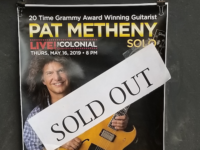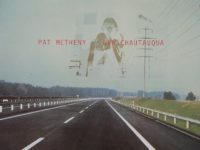by Mark Saleski
To get to a proper answer, we need to cast off the bias that’s draped over the question — that the digital reproduction of music is inherently better than the mechanical. With the Orchestrion project, Pat Metheny has shown that the two modes of technology can come together to create unexpected advancements in sound, composition, and improvisation that transcend concepts like “old’ and “new.”
Metheny has always had a free relationship with technology, so it’s not surprising to hear his account of the hours spent fascinated with his grandfather’s player piano. With his innovative use the digital tools such as the SynClavier and the guitar synthesizer, he was one of a handful of musicians whose ears were finely attuned to the possibilities of silicone-enhanced jazz.
This latest development, which employs a fusion of solenoid/pneumatic-actuated instruments with a digital front-end, gives Metheny a huge sonic palette to drawn on. There are loads of percussion instruments (including vibes, orchestral bells, drumkit, cymbals, and the like), electric bass, “guitarbots” (check out the video!), as well as a Yamaha Disklavier. The idea of a mechanically actuated guitar has a certain odd appeal for me, but my favorite instrument in this ensemble (if it can be called that) is the cabinet of tuned bottles, the “bottle organ.” It is a set of chromatically-tuned bottles that produce notes when blown with air. They also light up while sounding out, adding to the spectacle.
So let’s get back to it: Why? Hasn’t sampled playback technology come along far enough to replace old-fashioned mechanical instrumentation? Mostly, the answer is “No.” Or maybe: “Not quite.” While reproduction has come a long way, it’s not good enough to completely replace the real thing. There is a certain “something” about the power and presence of acoustic instruments that is still very difficult to reproduce with even the most-advanced modern recording and playback technologies.
If you listen to Orchestrion‘s five compositions, you can hear Metheny reveling in an environment that allows him to interact directly with his own vision of music. He’s created every single note via a guitar or keyboard, then improvising over his own ideas during playback. What’s more, Pat can drive any of the instruments in real-time as he plays the guitar. Since Metheny is so fond of having his melodic line followed by a second instrument (often performed by long-time collaborator Lyle Mays), this capability seems like a perfect fit.
The album’s title track kicks things off with a display that is very characteristic of Metheny’s style of melodic development. I think of this as the “long-form melody.” Pat tends to write melodies that extend over unusually long periods of time. That source material is then stretched across the musical landscape that’s constructed as time proceeds. While Orchestrion revisits that construct, what’s amazing is to hear how the interactions between all of the other instruments add color and character. The funny thing here is that the reflex is to describe this as “interaction,” when what’s really going on is interaction not in the “normal” sense, but interaction as Metheny “hears” it in his head. And yet…those notes from the vibes are indeed physically following that arpeggio from the piano, just as the bass is supporting the structure as it shifts.
Definitely a new way to think about what “interactive” means.
When I first read about Metheny’s intent, I wondered about how “human” it would end up sounding. Though percussion has always been very important to him (and he has played with a long list of incredible stickmen including Naná Vasconcelos, Roy Haynes, Don Alias, Armando Marçal, Jack DeJohnette, Paul Wertico, and Antonio Sanchez), I was a little skeptical that “the machine” would be too obvious. Right, go ahead and give “Soul Search” a listen. It opens with some bluesy bass/piano passages that Metheny plays over (Oh my, that “bottle organ” is beautiful), and adds in several layers of percussion before taking an abrupt mid-composition turn into straight swing. I’ll be damned if that ride cymbal doesn’t sound fantastic, as does the walking bassline that precedes Pat’s short tribute to Miles’ “Milestones.” Forget the technology, this is just great stuff.
It was during the closing “Spirit Of The Air” that I totally forgot this was only one person playing. The tune begins with a figure that is repeated until it becomes the main motif. Pat starts building his melody as the bass slips underneath and chimes ring out. In traditional jazz improv fashion, the “band” drops away to allow the guitar to riff over minimal percussion and bass. But wait…I’ve been fooled…there’s no band here! And again, as other bits of percussion are added back in and Metheny raises the intensity level, it’s very easy to forget what’s really going on.
And what IS going on, exactly? Honestly, just some great music. This is no hi/lo tech parlor trick. This is a curious musical mind unleashed. Pat has stated that, for this recording, he has used his Orchestrion in a more compositional mode, with most of the improvisation left to his guitar. Apparently, we can look forward to future experiments with “the machine” taking on a more prominent improvisational role.
All of this from a player piano in a basement in Manitowoc, Wisconsin. Digital is the future? Maybe.
- Why the Rolling Stones’ Harrowing ‘Gimme Shelter’ is Still Revealing New Depths - November 18, 2024
- How Talking Heads’ ‘Fear of Music’ Opened Up a World of Art and Sound - August 5, 2024
- How Deep Cuts Propelled Bruce Springsteen’s ‘Born in the U.S.A.’ - June 4, 2024





